#this is really just the beth tries to find ways to describe slightly different variations on brown hair challenge
Explore tagged Tumblr posts
Photo
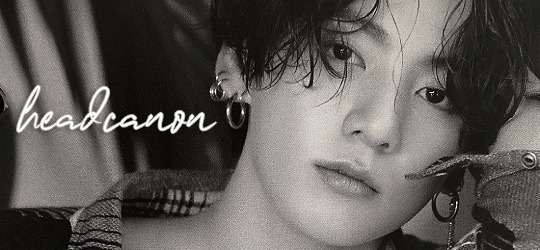
headcanon #019: hair through the eras
word count: 1,375 1,501 1,555 words
updated august 8, 2020 february 13, 2021 !
Mama (2012)
Ash debuted with what I would like to call shaggy emo hair. It was a little longer and wavier than he’d had normally in the most recent times pre-debut, but Ash quite liked this style for his hair at the time and had no complaints.
Wolf (2013)
It took over a year for Knight to comeback and during that time Ash had mostly kept his hairstyle from Mama era. It was only when it came time to shoot the music video and promotional photos they he was given a new hairdo for the era, which was a reddish-brown coif. The aim was to make him look a little older and a little sportier without making him look too mature since he was still one of the younger members of the group. Though he was only seventeen, he began to earn more attention for his visuals this era than he had in debut. Despite his negative opinions on nearly everything else about this era, he once again didn’t have any major complaints about his hair style, though he was attached to his debut era hair.
Growl (2013)
Growl was the first time Ash had an obviously unnatural hair color, as he was styled with a red bowl cut with angular bangs. As was the styling of the era, the style was chosen to look youthful and easy to style with a backwards baseball cap if they chose to put him in one. He went back to a natural color very quickly after this era finished, as he found the hair dye made his hair more brittle due to being particularly sensitive to it.
Overdose (2014)
For Overdose, Ash went back to an unnatural color with dark purple hair, usually styled in a comma hairstyle. It was a popular look for fans at the time, but Ash wouldn’t personally consider it one of his favorite hairstyles he’s ever had and he went back to a normal dark brown halfway through promotions due to the hair dye irritating him again. It was one of the more popular eras for him visually again, though. Fans seemed to like his hair styled to show his forehead.
Call Me Baby (2015)
For Call Me Baby, Ash’s hair was somewhat similar to the previous era with dark brown hair, though his bangs were shorter. He didn’t have much of an opinion on his styling this era, to be honest.
Love Me Right (2015)
For Love Me Right, Ash’s hair was lightened to a light brown with long bangs and some blonde highlights. Ash quite liked the longer bangs looks
Sing For You (2015)
While this is one of Ash’s favorite era’s musically, he probably couldn’t tell you what his hairstyle had been for it, but he had brown hair with asymmetrically parted bangs. His hair was pretty healthy at this point and it would continue to be saved from bleach for several more eras.
Monster / Lucky One (2016) & Lotto (2016)
His first two eras after his scandal brought one of his fans’ favorite hairstyles of all time, and Ash was happy that they had something to talk about other than his recent bad press. For Monster/Lucky One promotions, as well as the repackage promotions with Lotto, Ash had black comma hair.
Fanfare (2016) & Gorilla (2016) & Hey Mama! (2016)
The next three eras came incredibly close together with almost no break for Ash, so his hairstyle remained the same throughout all three — a brown wavy style that was easy to maintain.
Can You Feel It? (2016)
This time around, Ash got a medium brown bowl cut. Ash wasn’t a huge fan, but it was a popular style at the time that many other idols had and he didn’t say anything to stylists since he was just grateful he hadn’t been punished for his scandal with outrageous hairstyles.
Roar (2017)
Roar brought the first major hair color change for Ash since Overdose three years prior — a light brown/dirty blonde color generally styled with a wavy texture. The bleaching required to lighten his hair had taken a toll on it again, so the color didn’t last long past the end of music show promotions.
Easy Love (2017)
His hair was back to a light brown for Easy Love, one of his favorite eras musically, but again pretty forgettable as far as hairstyle. Stylists did sometimes give him pink highlights this era, namely for the music video and a select few music show performances and fan signs early in the promotion period.
Ko Ko Bop (2017)
For Kokobop, Ash’s hair was pretty much the same as it had been for Easy Love, light brown, though they had long ago given up on the pink highlights by this point. He was also on We Got Married’s special summer season during this time, so they wanted him to have an approachable and friendly look.
365 Fresh (2017) & Power (2017)
For these two eras, which included the first round of promotions Ash had ever done outside of his group, he went slightly darker with the brown and had some highlights to add texture. Unlike the past few eras, his hair was finally styled to expose his forehead again and was often styled for a wavy coif of bangs to frame his face. It was, again, a more popular era for him visually, as most eras where his bangs are styled out of his face tend to be.
I’m Young (2017) & O Sole Mio (2018) & Blooming Days (2018)
For his solo debut as well as the Knight era and the White Knight era following it, Ash ditched the shades of brown to go for a solid black that was generally styled with his bangs parted in the middle to show his forehead again. It could be argued this was the beginning of a more mature styling for him.
Critical Beauty (2018)
For Critical Beauty, Ash kept the black, though it was styled with his bangs to one side and out of his face and he had a bit of an undercut. Compared to his usual middle part, he had a side part this era. Ash liked this style, but it only lasted as long as music show promotions before he changed it again.
Tempo (2018) & Untitled, 2014 (2018)
Ash’s hair was initially dyed pink/red for the filming of his BC Portal “New Heroes”, but due to an overwhelmingly positive response, he kept it through the end of the year. By the time he was promoting Untitled, 2014, it was more of a faded pink or even simply blonde to spare his hair from all of the dye on top of the bleach.
Love Shot (2019)
After the damage his hair had suffered in the back half of 2018, it was obvious Ash would need to go back to a dark brown for Love Shot era. It matched the dark and sexy but sophisticated vibes of the song, anyway.
Troublemaker (2019)
For Troublemaker, Ash’s hair was still dark brown or black, but he had begun letting it grow out.
Now or Never (2019) & Now (2019)
For Knight’s next comeback as well as his second release with Yoona, he had continued letting his hair grow out and it was now dark and curly. Ash was really loving growing his hair out longer than he’d ever been allowed to have it be and if he hadn’t been so exhausted at time time, he would have been really feeling himself. As it hair got longer, it got more divisive, though, and there was a vocal minority of fans (and, even more so, anti-fans jumping on the opportunity to hate) who absolutely hated the new look and were more than happy to make it known in online comments and to his face.
Romanticism / D (Half Moon) (2019) & Enough (2020)
For his third solo album through now, Ash’s hair has been black and wavy, and at its longest. He’s not a very vain person, but he really does like how he looks these days and thinks he’s the closest to how he’d choose to look if he wasn’t an idol and had more of a say in how he presents himself.
Woo Ah (2020)
Ash cut his hair shortly before the release of his song. It was far more BC’s idea than his, but he sported a shorter hair style with blue-green ends for the short promotions of this song, often in a forehead-exposing, comma hair style. For several months after, as his hair began to slowly grow out again, he would still make appearances with green ends.
How Can I Love The Heartbreak, You’re The One I Love (2020)
The sound of this song was more of a classic sound, so Ash lost the dyed ends and instead stuck with dark brown/black hair that had grown out to a similar length as it had been around the same time the year before and generally styled wavy.
Bittersweet (2020)
For this comeback, Ash kept the longer dark hair that he’d had in his viral fancam a month prior, which was pretty similar to his hair from the previous solo album. His hair was permed during this time and throughout this period, he often styled his hair up in buns or ponytails.
#i love stealing i'm a stealer ♥#this is really just the beth tries to find ways to describe slightly different variations on brown hair challenge#*of brown hair#this is a good time for this though.... i hate to say it but this era of ash's hair will be ending... i know it pains me deeply too#&& holding on to something | headcanons#&& queued
2 notes
·
View notes
Note
Hi ! I'm sorry if you have already talked about that, I'm just new to the fandom. I just finished s3 and I've felt so conflicted since Lucy's death.. There was a sort of lightness in the show despite of the crime element and obvs flirtation between Brio.. But now, everything seems so dark and Beth is trying to kill him. I feel like there's been a shift and that they'll never be able to come back from it.. What are your thoughts ?? Thank you and stay safe !!
Hi! Welcome to the fandom, anon! :-)
Season three definitely has a darker feel overall, so I completely understand why you feel conflicted! I think you’re right too - the balance between the lighter elements of the show and the darker ones was really different in s3 compared to seasons 1 and 2, and it gave the season a very different energy. Interestingly though, I don’t actually think the content itself was all that much darker, but rather that shift was felt more in the way that that content was framed and paced.
After all, violence – and the threat of violence – has been a pretty integral part of the show since it began, and while I think there’s a bit to be said about how much of the violence of the show made its way from subtext to text – Eddie’s death happened off-screen, but Lucy’s didn’t, for instance – I also think that there have been moments of textual violence since the show began. Beth knocked Boomer out with a whiskey bottle after he’d tried to rape Annie in the very first episode after all, something that was echoed with Boomer’s completed rape of Mary Pat and her hitting him with her car in 2.03. In that sense, the violence might’ve escalated in some ways across the first two seasons – culminating with Beth shooting Rio in 2.13 – but it’s always been a part of the DNA of the show overall.
In that sense, I think what’s really changed isn’t so much the violence and threat of violence itself, but rather the way that the show frames that violence and the effect that has on the pacing, tone and character beats.
So hey! Let’s break that down a little.
Catch and Release
When it comes to scenes of intense drama or violence – played out or inferred – Good Girls is really a show that, at least for its first two seasons, relies on a pretty defined structure that I’d say goes something like this:
1. Contextual joke that builds tension and/or sets mood.
2. Act of violence or drama.
3. Throwaway joke that breaks tension and/or resets mood.
As a structure, it’s generally pretty effective and is ultimately used to manage the tone of the episode. After all, for a show like Good Girls which is a dramedy, leaning too hard on the joke or too hard on the drama can create the off-balanced feeling we got in s3, but I’ll come back to that later.
This structure essentially presents the violence or drama of the scene as the meat of a burger, allowing the jokes to both complete the meal (delicious!) while also softening up the richness or intensity of the meat itself.
Generally speaking, I’d say Good Girls did this quite simply and effectively in s1, experimented and tested the elastic of it in s2, and more or less got rid of one crucial step in s3. It makes for an interesting exploration of narrative structure, I think, but that’s just because I find this sort of stuff interesting to explore, haha.
So what’s that actually look like in action?
Okay, let’s take 1.01 with the scene I described above.
1. Contextual joke that builds tension or sets mood
I’d say in this case it was the entire scene at the end of the episode where Annie, Beth and Ruby are arguing about what to do about Rio.

2. Act of Violence
Boomer attempts to rape Annie, Beth hits Boomer, Boomer falls into the coffee table.
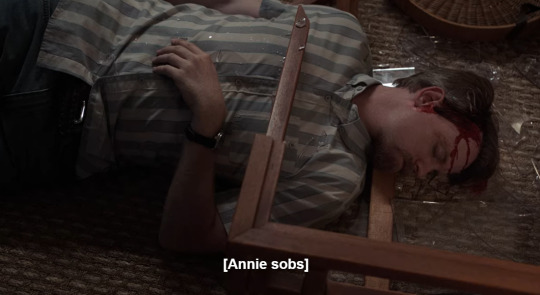
3. Throwaway joke that breaks tension and resets mood.

And again in 1.02.
1. Contextual joke that builds tension or sets mood
Annie trying to sell Rio on the dolls.

2. Act of Violence
Rio ordering Mick to kill Beth.

3. Throwaway joke that breaks tension and resets mood.
Boomer popping out of the treehouse.

(please forgive my horrible screencaps, I took these after I’d written this post and it’s now late, hahah)
Annnnd again in 1.04
1:
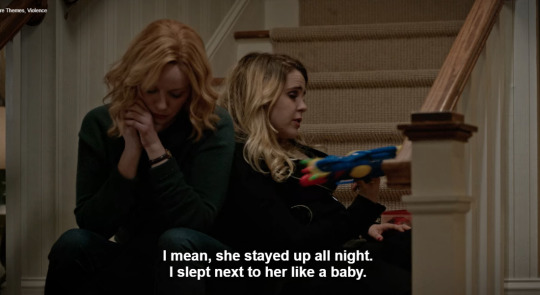
2:
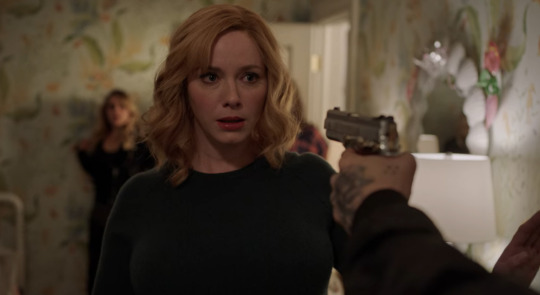
3:

By 1.09, they were already starting to leave wider gaps between the jokes and the tension – which makes sense as it was building towards the climax and they were wanting more drama than comedy – but importantly, this framing was still present.
1: The girls joking about the van job
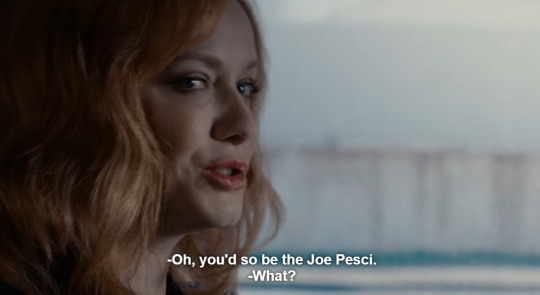
2: The tense climax of the van job

3: The joke about the result of the tense climax

And in 2.01, it kept those gaps big as a direct continuation.
1. Contextual joke that builds tension
Beth putting the mug on the coaster as she scrubs blood off her floor.

2. Rio shooting Dean in a flashback.

3. Annie and Ruby bickering about Annie stealing a hospital meal (tone reset as a result of violent climax)

The series went on to test this further in s2 by adding extra beats to create more complex (and interesting, in my opinion!) variations. The clearest example of this is in 2.03 with the Boomer and Mary Pat sequence:
1. Tension establishing joke: the girls in the hotel bickering about the price of the room.

2. An act of inferred violence – Boomer rapes Mary Pat

3. An act of textual violence that builds off both the joke and the inferred violence of the previous scene – Mary Pat runs over Boomer.
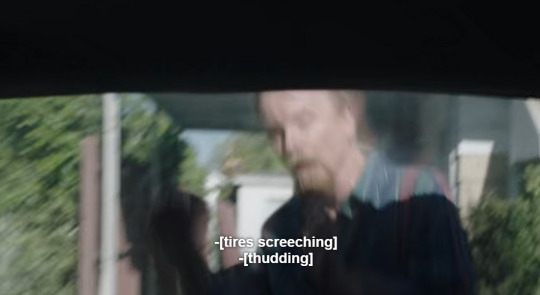
4. A throwaway joke as a tension breaker – Mary Pat worried her kids have heard only to see them engrossed in their devices while the Power of Love plays in the background.
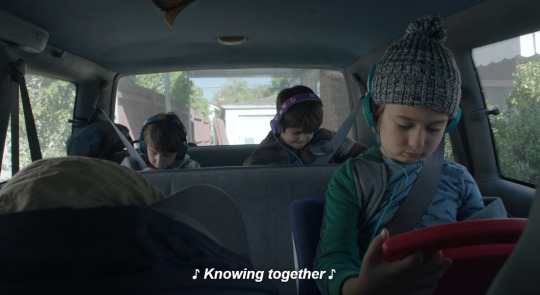
5. Takes us straight into an even better tension breaker joke with Mary Pat telling the girls she chopped Boomer up.

(That is such. good. snowballing. tension. And I could talk about it forever. Like, seriously. It’s not a sequence we talk about a lot, but 2.03 is an excellent example of complex dramedy writing).
That said, it often still fell back on that classic structure too in satisfying ways. 2.07 being a perfect example.
1. Contextual joke to establish tension
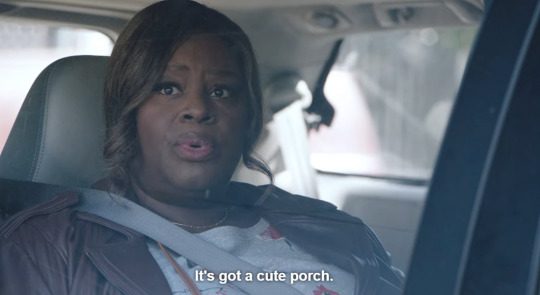
2. Tension / act of violence
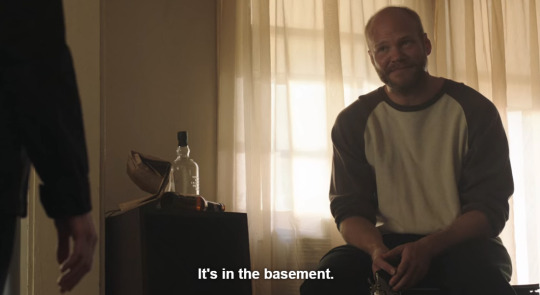
3. Tension breaker.

Whiiiich brings us to 2.13.
King
Look, 2.13 doesn’t work for a lot of reasons, but in no small part, it doesn’t work because it doesn’t play with the above structure like the Mary Pat and Boomer arc did in 2.03, nor test the elasticity of it like 1.09 and 2.01 do, rather it completely abandons it altogether.
It doesn’t build tension effectively through that blend of drama and comedy that the show can do really well, nor does it break it afterwards for us with a lighter moment that commentates on that tension, rather it thrusts the violence and drama onto us in a way that wasn’t well established narratively, and – quite frankly – was badly written.
I could talk a lot more about why that narrative choice doesn’t work, but that’s not really what we’re here to talk about. What we’re here to talk about is:
A Change of Pace
Because the thing is, season 3 does actually return to it’s s1 and s2 structure, only with one, crucial change.
It abandons Step 3: the joke that resets the mood.
What this means is that we have the contextual joke which establishes the tension and the mood, and the tension, but then the tension’s never actually broken for us afterwards.
This is perhaps clearest in 3.05 with Lucy’s murder.
1. We have the establishing joke with the girls debating which Au Jus hostage photo to use.

2. We have the act of violence.
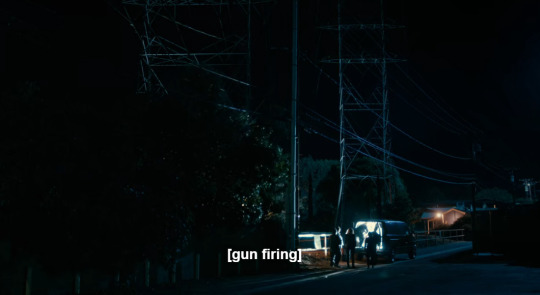
And then we have only aftermath.
Ruby crawls into bed with Stan, Annie with Ben, and Beth takes Au Jus home.
On it’s own, I think this is an effective break from structure. I think it underscores the power of this sequence overall and the importance of Lucy’s death as a narrative moment and the ‘innocence lost’ theme.
Only it’s not on it’s own.
The season kept breaking structure. Over and over again.
It happens after Rio kills Turner in 3.01 (there’s a slightly lighter scene that caps that with Rio checking out of the hotel, so you could kind of argue that it was returning to the same structure, but it doesn’t quite hit the mark for me), it happens when Rio confronts Beth in 3.03 and when he takes her to the OBGYN, it happens when Max tries to confront Rio at the bar in 3.06, and it happens in most of the scenes with the hitman.
In fact, I’d argue that the only scenes that returned to the catch and release structure in s3 were the scene where Ruby stole the hockey jersey, the carwash scene which ended with Mick wanting to go to IHOP and, most effectively, in the Sweet P’s job in 3.10.
You’re talking a lot about sequence structure here, Sophie.
Right! Sorry! Tangents, haha.
What I’m getting at is that I don’t think the content of the show itself is any different. Murder, crime, intimidation and violence has been central to the show’s DNA since 1.01, and a lot of this has been textual. Lucy’s death I think definitely feels different because she’s the first true innocent we’ve seen killed on this show, but y’know, Rio was threatening to murder random PTA moms way back in 1.07 when Beth’s secret shopper scheme proved – err, unvetted, and Dean was trying to organise hitmen in s2 too.
Structure is important. Structure is what sets up audience expectations and establishes the rhythm of a story as well as – most importantly for this discussion – the tone of one. Seasons 1 and 2 presented the dramatic and comedic elements of the show ultimately as a marriage. The comedy was used frequently to guide us as viewers in and out of tension, and ultimately, I think this is why season 3 felt so different. That three point sequence structure was unbraided, the comedy divorced from the drama, which stuttered the rhythm and ultimately affected the tone.
SO, in answering your question as to whether or not the show can come back from the darkness to find its balance again, yeah, I think it can!
I think the writers sort of wrote themselves into a big, ugly corner with 2.13 and spent a lot of s3 struggling to find a way back out of it. Like, I think on a narrative and a character level, they had to show Rio kill someone in s3 to re-establish him as a character with teeth, because if they hadn’t, he wouldn’t have been the source of tension and conflict that they rely on him to be. I think they committed themselves to darker elements of Beth’s character and to asking the question of what it is the girls are capable of, because that’s the sort of thing you commit yourself to when you throw a grenade into your own story like they did with 2.13.
And look, I don’t think they got themselves out of it perfectly by any stretch of the imagination – in particular sacrificing parts of the way they typically structured tension in violence as they tried to reset the board meant they ultimately also chose to sacrifice both rhythm and tone too – but I think they were rebuilding by the end of s3. I think the Sweet P’s job was this show at it’s tonal best, with that marriage of comedy and anticipation and both personal and criminal stakes really working together to build a great sequence (Beth and the Caesar Salad! Anticipation building with Ruby and Stan as Stan figures out what’s happening! A crime plot! Stan coming through in the end!)
I think the note the show chose to end the season on with the promise of Boland Bubbles, Ruby and Stan reconnecting and the first glimpse of Phoebe infiltrating the girls does reset the board in a way that leaves a lot more room for lightness than the end of season 2 did, while still offering hooks of conflict and tension too. I also think it allows for a return to the sort of sequence structure that lets the show balance it’s tone in a way that 2.13 frankly didn’t.
Of course, that’s ultimately if they decide to return to it, haha. I hope they do, and I think we were heading there, but I guess we’ll just have to wait and see! :-)
#and thank YOU anon#i've been thinking about this for a while haha#but i spend an embarrassing amount of time thinking about story structure#this was extremely fun to write!#it's been a while since i actually wrote long analysis#i think maybe i just needed a break#i have a bunch of asks inviting long analysis in my inbox too#maybe i'll try and do another one this week before i go to the water#we'll see!#nbc good girls#writing#gosh i don't even know what to tag this as haha#welcome to my ama#and stay safe too anon <3#Anonymous
22 notes
·
View notes